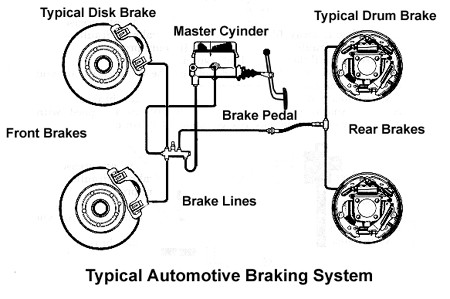The car brake system is a complex assembly of interconnected parts that work in perfect harmony to ensure your vehicle slows down or stops safely and effectively. For any driver, understanding the fundamental Car Brake System Parts is not just a matter of curiosity, but a crucial aspect of vehicle ownership and safety.
Why is it important for a driver to be familiar with the car brake system parts? While you might not be a mechanic, knowing the components of your car’s braking system offers several key advantages. Firstly, it provides a fundamental understanding of how your car stops, enhancing your awareness of vehicle operation. Secondly, and perhaps more practically, it equips you with knowledge that can be economically beneficial. Recognizing potential issues and understanding repair needs can help you make informed decisions about maintenance and avoid unnecessary expenses.
In this guide, we will delve into the major car brake system parts, exploring their functions and importance within the overall braking mechanism.
Chapter 1: Disc Brake System Components
Disc brakes are a common type of braking system in modern vehicles, particularly on the front wheels, known for their effective stopping power. Let’s examine the key car brake system parts within a disc brake setup:
– Brake Pads
Brake pads are essential friction components in a disc brake system. These block-like structures are designed to press against the brake rotor when you apply the brakes. This friction is what slows down or stops the rotation of the wheels. Brake pads are engineered to provide high friction and withstand significant heat generated during braking. They are typically made with friction materials bonded to a metal backing plate. It’s crucial to understand that brake pad linings wear down over time due to friction, necessitating regular brake pad replacement as part of routine vehicle maintenance. Different types of brake pads are available, varying in material composition and performance characteristics to suit different driving needs and vehicle types.
– Brake Rotor
The brake rotor, also known as a brake disc, is a critical car brake system part. It serves as the rotating surface against which the brake pads are pressed. The rotor is directly connected to the wheel and rotates with it. When the brake pads clamp onto the rotor, the resulting friction converts kinetic energy into heat, slowing the vehicle. Brake rotors are typically made of cast iron, designed to dissipate heat effectively. Similar to brake pads, brake rotors are subject to wear and tear. Over time, they can become worn, warped, or develop grooves. When a brake rotor reaches its minimum thickness or exhibits damage, it needs to be replaced. Consulting a reputable brake rotor manufacturer or mechanic is essential for sourcing quality replacement rotors.
– Brake Caliper
Brake calipers are vital components responsible for the mechanical function of the disc brake system. Their primary function is to house the brake pads and control their movement. When you press the brake pedal, hydraulic pressure is applied to the caliper, causing pistons within the caliper to push the brake pads against the rotor. Conversely, when you release the brake pedal, the caliper retracts the pads away from the rotor, allowing the wheel to rotate freely again. There are two main types of brake calipers: fixed calipers and floating calipers, each with slightly different designs and mechanisms for applying braking force. Like other car brake system parts, calipers can also require maintenance or replacement. Signs of caliper issues include brake fluid leaks or uneven brake pad wear, indicating potential problems that need attention.
Chapter 2: Drum Brake System Components
While disc brakes are prevalent in front wheels, drum brakes are still utilized in many modern vehicles, often on the rear wheels. Drum brakes offer a different design approach to braking. Let’s explore the essential car brake system parts of a drum brake system:
– Brake Shoes
Brake shoes in a drum brake system are analogous to brake pads in a disc brake system in their function. They are curved components lined with friction material designed to press against the inside surface of the brake drum. When the brakes are applied, the brake shoes are forced outwards against the rotating drum, creating friction to slow or stop the wheel. Like brake pads, brake shoe linings are made of durable friction material that wears down over time. Periodic inspection and brake shoe replacement are necessary to maintain effective drum brake performance.
– Brake Drum
The brake drum is a cylindrical car brake system part that encloses the other drum brake components. It is a metal drum that rotates along with the wheel. The inner surface of the brake drum serves as the friction surface for the brake shoes. When the brake shoes are pressed outwards, they make contact with the inner drum surface, generating friction that slows the wheel’s rotation. Brake drums are robust components but can also be subject to wear and damage. Overheating or excessive wear can lead to warped brake drums, which can cause vibrations and reduced braking efficiency. Warped brake drums require replacement to ensure proper braking performance.
– Backing Plate
The backing plate is a foundational car brake system part in a drum brake assembly. It is a stationary plate that provides a mounting point and support for all other drum brake components, including the brake shoes, wheel cylinder, and various springs and hardware. The backing plate keeps all the drum brake parts properly positioned and functioning as a cohesive unit within the wheel assembly.
Chapter 3: Brake System Hardware and Accessories
Beyond the primary components of disc and drum brakes, several other car brake system parts, hardware, and accessories play crucial roles in the overall functionality and effectiveness of the braking system. These elements contribute to smooth operation, proper brake engagement, and enhanced safety.
– Return Springs
Return springs are essential hardware components specifically used in drum brake systems. Their function is to retract the brake shoes back to their resting position, away from the brake drum, once the brake pedal is released. This ensures that the brakes are not dragging and allows the wheels to rotate freely when braking force is not applied. Return springs are critical for preventing brake drag, which can lead to overheating, reduced fuel efficiency, and accelerated wear of brake components.
– Wheel Cylinder
The wheel cylinder is a hydraulic component found in drum brake systems. It houses pistons that are activated by hydraulic pressure from the master cylinder when the brake pedal is pressed. These pistons, in turn, push the brake shoes outwards towards the brake drum, initiating the braking action. Wheel cylinders are subjected to hydraulic pressure and can wear out or leak brake fluid over time. Signs of a failing wheel cylinder, such as brake fluid leaks or reduced braking performance, necessitate wheel cylinder replacement to maintain brake system integrity.
– Anti-Lock Braking System (ABS)
The Anti-Lock Braking System (ABS) is a critical safety accessory in modern vehicles. While not a direct braking component, it is an integrated system that significantly enhances brake control, especially in emergency braking situations or on slippery surfaces. ABS works by preventing the wheels from locking up during hard braking. Wheel lock-up can lead to skidding and loss of steering control. ABS uses sensors to detect wheel deceleration and, if lock-up is imminent, modulates the braking pressure at individual wheels. This allows the driver to maintain steering control during hard braking and often results in shorter stopping distances, particularly on wet or icy roads. ABS is a vital safety feature that relies on various sensors, control units, and hydraulic modulators working in conjunction with the traditional car brake system parts.
Chapter 4: Types of Brake Systems
It’s important to distinguish between car brake system parts and types of brake systems. “Brake system” can refer to the overall method of braking employed in a vehicle. Brake components are the physical parts that constitute any braking system. Brake systems can be categorized based on their operating principles:
- Electromagnetic Braking System: Utilizes electric motors and electromagnetic forces to apply braking. Often found in electric vehicles and hybrid cars as part of regenerative braking systems.
- Hydraulic Brake System: The most common type in modern cars, using hydraulic fluid pressure to transmit force from the brake pedal to the brake components at the wheels. Disc brakes and drum brakes are typically hydraulically operated.
- Mechanical Brake System: Relies on mechanical linkages, such as cables and rods, to transmit force. Often used in parking brakes or older vehicle designs.
- Servo Brake System (Vacuum Assisted Braking): Enhances hydraulic brake systems by using vacuum pressure from the engine intake manifold to assist brake pedal application, reducing driver effort.
Within these system types, the two most common types of brakes themselves, based on design, are disc brakes and drum brakes, as discussed in previous chapters. Both disc and drum brakes operate on the principle of friction to slow or stop a vehicle, but their construction and component arrangement differ significantly. Both types also require component replacement when parts become worn or damaged.
Conclusion
Understanding the car brake system parts is more than just technical knowledge; it’s about responsible vehicle ownership and safety awareness. A typical car has brakes on all four wheels, with front brakes generally handling a larger proportion of the braking force. By familiarizing yourself with components like brake pads, rotors, calipers, shoes, and drums, you’ll be better equipped to understand potential brake issues and communicate effectively with mechanics. Whether it’s a worn brake pad, a scored rotor, or any other component needing attention, your knowledge of car brake system parts empowers you to make informed decisions about your vehicle’s maintenance and ensure your safety on the road.

